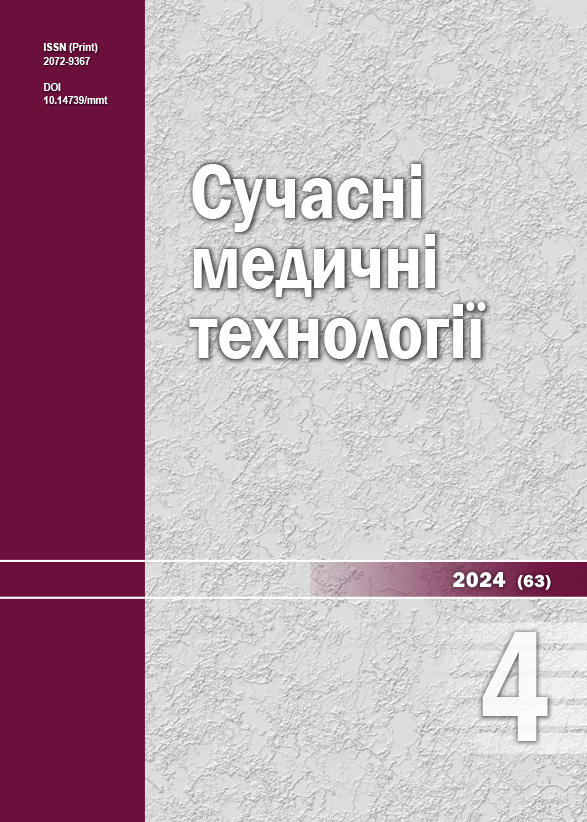Predictors of severe community-acquired pneumonia associated with coronavirus infection
DOI:
https://doi.org/10.14739/mmt.2024.4.301780Keywords:
pneumonia, coronavirus infection, COVID-19, SARS-CoV-2, interleukin-6, interleukin-10, hs-CRPAbstract
Aim of the study. To determine the predictors of severe community-acquired pneumonia associated with coronavirus infection.
Materials and methods. To achieve the aim and solve the problems, an open, prospective observational study was conducted: from January 2021 to February 2022, 102 patients with community-acquired pneumonia (CAP) aged 40 to 65 years with a positive test for SARS-CoV-2 were observed in the outpatient department of the Kherson City Clinical Hospital named after Athanasius and Olga Tropinin of the Kherson City Council. Determination of interleukin-6, interleukin-10, and high-sensitivity C-reactive protein (hs-CRP) was performed in blood plasma by enzyme-linked immunosorbent assay using standardized kits: “hs-CRP-ELISA-Best”, “IL-6-ELISA-Best”, “IL-10-ELISA-Best” in accordance with the attached instructions.
Results. The analysis of univariate logistic regression models showed that such indicators as patient age, heart rate and SpO2 were not important in the occurrence of severe CAP. Indicators such as vital capacity of the lung, blood glucose, C-reactive protein, IL-6 and IL-6 / IL-10 ratio were predictors of severe CAP according to the results of logistic regression analysis. Blood glucose, IL-6, and the IL-6 / IL-10 ratio lost their prognostic power in multivariable logistic regression models of severe CAP. According to the results of multivariate regression analysis, the predictors of severe CAP were the volume of lung lesions on computed tomography (CT) and the level of hs-CRP. Multivariate logistic regression analysis showed that independent predictors of severe CAP were the volume of lung lesion more than 20 % on CT (OR = 1.28, 95 % CI OR 1.11–1.48), and the level of hs-C-reactive protein >13.50 mg/L (OR = 2.22, 95 % CI OR 1.50–3.31). In terms of predicting the development of severe CAP, hs-CRP has an advantage over the standard model (AUC = 0.92 vs AUC = 0.72, p < 0.05).
Conclusions. According to multivariate logistic regression analysis, the following independent predictors were most significant for the occurrence of severe community-acquired pneumonia associated with coronavirus infection: lung lesion volume on CT and high hs-CRP. These indicators also had the largest areas under the ROC curve among those analyzed. Determining the level of C-reactive protein by a highly sensitive method is important for patients with moderate pneumonia associated with coronavirus infection to assess the risk of severe disease.
References
Phelan AL, Katz R, Gostin LO. The novel coronavirus originating in Wuhan, China: challenges for global health governance. JAMA. 2020;323(8):709-10. doi: https://doi.org/10.1001/jama.2020.1097
Hoehl S, Rabenau H, Berger A, Kortenbusch M, Cinatl J, Bojkova D, et al. Evidence of SARS-CoV-2 Infection in Returning Travelers from Wuhan, China. N Engl J Med. 2020;382(13):1278-80. doi: https://doi.org/10.1056/NEJMc2001899
Chen N, Zhou M, Dong X, Qu J, Gong F, Han Y, et al. Epidemiological and clinical characteristics of 99 cases of 2019 novel coronavirus pneumonia in Wuhan, China: a descriptive study. Lancet. 2020;395(10223):507-13. doi: https://doi.org/10.1016/S0140-6736(20)30211-7
Li LQ, Huang T, Wang YQ, Wang ZP, Liang Y, Huang TB, et al. COVID-19 patients’ clinical characteristics, discharge rate, and fatality rate of meta-analysis. J Med Virol. 2020;92(6):577-83. doi: https://doi.org/10.1002/jmv.25757
Zhang J, Yu M, Tong S, Liu LY, Tang LV. Predictive factors for disease progression in hospitalized patients with coronavirus disease 2019 in Wuhan, China. J Clin Virol. 2020;127:104392. doi: https://doi.org/10.1016/j.jcv.2020.104392
Tan L, Kang X, Ji X, Li G, Wang Q, Li Y, et al. Validation of Predictors of Disease Severity and Outcomes in COVID-19 Patients: A Descriptive and Retrospective Study. Med. 2020;1(1):128-38.e3. doi: https://doi.org/10.1016/j.medj.2020.05.002
Gallo Marin B, Aghagoli G, Lavine K, Yang L, Siff EJ, Chiang SS, et al. Predictors of COVID-19 severity: A literature review. Rev Med Virol. 2021;31(1):1-10. doi: https://doi.org/10.1002/rmv.2146
Makhoul E, Aklinski JL, Miller J, Leonard C, Backer S, Kahar P, et al. A Review of COVID-19 in Relation to Metabolic Syndrome: Obesity, Hypertension, Diabetes, and Dyslipidemia. Cureus. 2022;14(7):e27438. doi: https://doi.org/10.7759/cureus.27438
Huang C, Wang Y, Li X, Ren L, Zhao J, Hu Y, et al. Clinical features of patients infected with 2019 novel coronavirus in Wuhan, China. Lancet. 2020;395(10223):497-506. doi: https://doi.org/10.1016/S0140-6736(20)30183-5
Mehta P, McAuley DF, Brown M, Sanchez E, Tattersall RS, Manson JJ; HLH Across Speciality Collaboration, UK. COVID-19: consider cytokine storm syndromes and immunosuppression. Lancet. 2020;395(10229):1033-4. doi: https://doi.org/10.1016/S0140-6736(20)30628-0
Gao Y, Li T, Han M, Li X, Wu D, Xu Y, et al. Diagnostic utility of clinical laboratory data determinations for patients with the severe COVID-19. J Med Virol. 2020;92(7):791-6. doi: https://doi.org/10.1002/jmv.25770
Riveiro-Barciela M, Labrador-Horrillo M, Camps-Relats L, González-Sans D, Ventura-Cots M, Terrones-Peinador M, et al. Simple predictive models identify patients with COVID-19 pneumonia and poor prognosis. PLoS One. 2020;15(12):e0244627. doi: https://doi.org/10.1371/journal.pone.0244627
Ahnach M, Zbiri S, Nejjari S, Ousti F, Elkettani C. C-reactive protein as an early predictor of COVID-19 severity. J Med Biochem. 2020;39(4):500-7. doi: https://doi.org/10.5937/jomb0-27554
Vasileva D, Badawi A. C-reactive protein as a biomarker of severe H1N1 influenza. Inflamm Res. 2019;68(1):39-46. doi: https://doi.org/10.1007/s00011-018-1188-x
Ali N. Elevated level of C-reactive protein may be an early marker to predict risk for severity of COVID-19. J Med Virol. 2020;92(11):2409-11. doi: https://doi.org/10.1002/jmv.26097
Wang L. C-reactive protein levels in the early stage of COVID-19. Med Mal Infect. 2020;50(4):332-4. doi: https://doi.org/10.1016/j.medmal.2020.03.007
Downloads
Additional Files
Published
How to Cite
Issue
Section
License
The work is provided under the terms of the Public Offer and of Creative Commons Attribution-NonCommercial 4.0 International (CC BY-NC 4.0). This license allows an unlimited number of persons to reproduce and share the Licensed Material in all media and formats. Any use of the Licensed Material shall contain an identification of its Creator(s) and must be for non-commercial purposes only.














